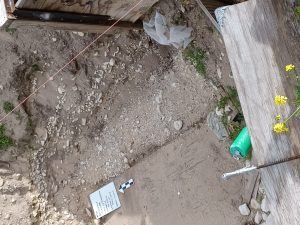
At the halfway point of the archaeological field season, we have already met one of our goals for the summer, the completion of the southeast cellar. We have removed the floorboards, wall planks and cultural deposit leaving only rocky beach sand. The last artifacts we found were bones from a mouse or other small rodent.
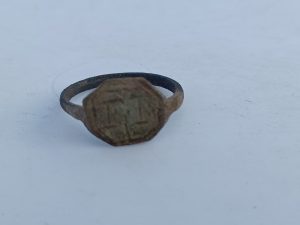 With one cellar complete, we have moved back to the central cellar. It has already yielded a broken hawk bell and a brass trade ring. Originally used for falconry, hawk bells, small jingle bells, were used for musical decoration on clothing and other items at Michilimackinac. The trade ring is of the type sometimes referred to as “Jesuit rings,” but by the eighteenth century they had lost their religious meaning and were merely secular trinkets in the fur trade.
With one cellar complete, we have moved back to the central cellar. It has already yielded a broken hawk bell and a brass trade ring. Originally used for falconry, hawk bells, small jingle bells, were used for musical decoration on clothing and other items at Michilimackinac. The trade ring is of the type sometimes referred to as “Jesuit rings,” but by the eighteenth century they had lost their religious meaning and were merely secular trinkets in the fur trade.
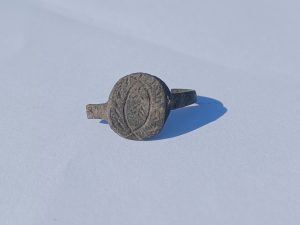 We are also making good progress in the area of the north wall and porch joists. The east end of this area is dominated by the stump from a tree planted in 1910 in an effort to make the new state park more beautiful. When we removed the last patch of 1781 demolition rubble from among the roots on the north side of the tree we found another brass trade ring.
We are also making good progress in the area of the north wall and porch joists. The east end of this area is dominated by the stump from a tree planted in 1910 in an effort to make the new state park more beautiful. When we removed the last patch of 1781 demolition rubble from among the roots on the north side of the tree we found another brass trade ring.
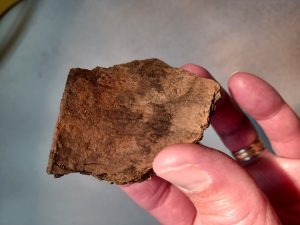 Our most unusual finds of the season (so far) were pieces of Native American pottery among the roots on the east side of the tree. They were deeper than the ring, in otherwise sterile beach sand pre-dating the fort. The sherds are grit-tempered, with a squared-off lip, and a gently sloping neck. They are badly burned, but appear to have been decorated by pressing cords into the surface of the clay when it was still wet. One hundred sixty-five similar sherds were found at the bottom of the quadrant to the east during the excavation of House D.
Our most unusual finds of the season (so far) were pieces of Native American pottery among the roots on the east side of the tree. They were deeper than the ring, in otherwise sterile beach sand pre-dating the fort. The sherds are grit-tempered, with a squared-off lip, and a gently sloping neck. They are badly burned, but appear to have been decorated by pressing cords into the surface of the clay when it was still wet. One hundred sixty-five similar sherds were found at the bottom of the quadrant to the east during the excavation of House D.
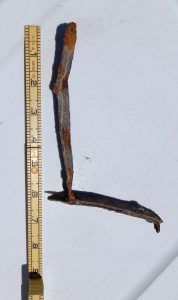
Other interesting artifacts unearthed to date are more typical of previous finds at this house. A bent, one-foot-long section of one-inch-wide iron barrel band is a reminder of the important role of trade at Michilimackinac. The base of a glass goblet is more evidence for the fashionable lifestyle of the English trader who owned this house in the 1760s and 1770s. Both of these were found in the west end of the porch area.
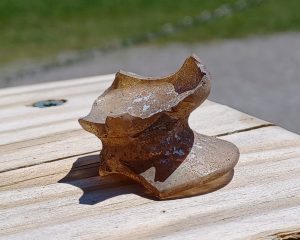
The excavation will continue daily, weather permitting, through August 17. The site is located just south of the parade ground within the walls of Colonial Michilimackinac.









